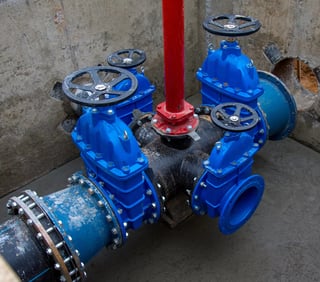GATE VALVE
Gate Valve: Overview & Functions
A gate valve is a linear-motion valve used to either fully open or fully close the flow of liquids, gases, or slurries in pipelines. It is commonly used in applications that require isolation rather than flow regulation due to its low-pressure drop and unobstructed flow path.
Functions of a Gate Valve
Flow Isolation: Provides a tight shut-off to stop fluid movement.
Minimal Pressure Drop: When fully open, the gate valve offers an almost straight-through path, reducing turbulence.
Bidirectional Flow Control: Can be used in either direction.
Handles High-Pressure & High-Temperature Applications: Suitable for steam, oil & gas, water, and chemical processing.
Types of Gate Valves
Rising Stem vs. Non-Rising Stem
Rising Stem Gate Valve: The stem moves up when opening, providing a visual indication of valve position.
Non-Rising Stem Gate Valve: The stem does not extend outward, ideal for underground and confined spaces.
Solid vs. Flexible Wedge
Solid Wedge: A single-piece, strong design for high-pressure and high-temperature applications.
Flexible Wedge: Allows slight movement, preventing thermal expansion issues.
Parallel vs. Wedge Gate Valve
Parallel Gate Valve: Uses two parallel discs to create a tight seal, common in steam applications.
Wedge Gate Valve: Uses an angled gate that fits into a matching seat for better sealing.
Slab vs. Expanding Gate Valve
Slab Gate Valve: A simple, flat gate used in oil & gas pipelines.
Expanding Gate Valve: Uses two pieces that expand against the seat for a tighter seal, often found in high-pressure applications.
Key Components
Body – Main structure, typically made of cast iron, steel, stainless steel, or bronze.
Gate (Disc) – Moves up and down to block or allow flow.
Stem – Connects the gate to the handwheel or actuator for movement.
Bonnet – Houses the stem and seals, protecting internal components.
Seat Rings – Provide sealing between the gate and valve body.
Handwheel/Actuator – Manual or automated control for opening/closing.
Applications of Gate Valves
✅ Oil & Gas Pipelines – Used in transmission and refining processes.
✅ Water Treatment & Distribution – Controls water flow in municipal systems.
✅ Power Plants – Regulates steam and cooling systems.
✅ Chemical & Petrochemical Industries – Handles corrosive fluids safely.
✅ Marine & Offshore – Used in shipbuilding and offshore platforms.
Advantages of Gate Valves
✔ Tight Shut-Off – Provides a strong seal to prevent leaks.
✔ Full Bore Design – No flow restriction when fully open.
✔ Durability – Suitable for extreme conditions.
✔ Low Maintenance – Fewer moving parts compared to other valve types.
Disadvantages of Gate Valves
❌ Slow Operation – Takes time to open/close fully.
❌ Not Ideal for Throttling – Partial opening can cause seat damage due to turbulence.
❌ Large Space Requirement – Needs sufficient clearance for full stem movement.



